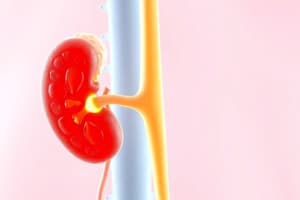Podcast
Questions and Answers
What triggers the release of aldosterone?
What triggers the release of aldosterone?
- Decreased blood pressure (correct)
- Increased serum osmolality
- Increased blood pressure
- Decreased serum osmolality
What is the primary function of the Renin-Angiotensin-Aldosterone System (RAAS)?
What is the primary function of the Renin-Angiotensin-Aldosterone System (RAAS)?
- Regulating fluid intake
- Regulating fluid output and blood pressure (correct)
- Promoting sodium excretion
- Stimulating thirst
What is the primary impact of aldosterone on the body?
What is the primary impact of aldosterone on the body?
- Increased fluid loss through the kidneys
- Decreased sodium reabsorption
- Increased sodium reabsorption leading to increased serum osmolality (correct)
- Increased sodium excretion
Which of the following contribute to the loss of fluids in the body?
Which of the following contribute to the loss of fluids in the body?
What are the main regulatory mechanisms for water balance in the body?
What are the main regulatory mechanisms for water balance in the body?
How does angiotensin II contribute to the regulation of blood pressure?
How does angiotensin II contribute to the regulation of blood pressure?
What are the potential consequences of impaired thirst perception?
What are the potential consequences of impaired thirst perception?
What is the role of the Kallikrein-Kallidin System in fluid and electrolyte regulation?
What is the role of the Kallikrein-Kallidin System in fluid and electrolyte regulation?
What is the primary cation present in the intracellular compartment?
What is the primary cation present in the intracellular compartment?
Which of the following is NOT a mechanism of fluid and solute movement within the body?
Which of the following is NOT a mechanism of fluid and solute movement within the body?
What is the approximate value of the anion gap in the blood?
What is the approximate value of the anion gap in the blood?
Which of the following factors is NOT directly involved in regulating body fluid distribution and homeostasis?
Which of the following factors is NOT directly involved in regulating body fluid distribution and homeostasis?
What is the simplest and best formula to calculate plasma osmolality?
What is the simplest and best formula to calculate plasma osmolality?
What is the typical fluid intake and output balance for an average adult?
What is the typical fluid intake and output balance for an average adult?
Which of the following is NOT a parameter typically measured in a urinary ionogram?
Which of the following is NOT a parameter typically measured in a urinary ionogram?
What is the primary reason to avoid collecting hemolyzed samples for potassium (K⁺) measurements?
What is the primary reason to avoid collecting hemolyzed samples for potassium (K⁺) measurements?
Which method is NOT typically used to measure sodium (Na⁺) and potassium (K⁺) levels in blood?
Which method is NOT typically used to measure sodium (Na⁺) and potassium (K⁺) levels in blood?
What is the normal range for potassium (K⁺) in blood?
What is the normal range for potassium (K⁺) in blood?
Which of the following is a potential cause of hypokalemia (low potassium levels)?
Which of the following is a potential cause of hypokalemia (low potassium levels)?
What is the significance of the urinary Na+/K+ ratio being greater than 1 in a healthy individual?
What is the significance of the urinary Na+/K+ ratio being greater than 1 in a healthy individual?
In the context of electrolyte balance, what is the primary function of aldosterone?
In the context of electrolyte balance, what is the primary function of aldosterone?
What is the normal range for hematocrit in women?
What is the normal range for hematocrit in women?
Which of the following is NOT a potential cause of hypernatremia (high sodium levels)?
Which of the following is NOT a potential cause of hypernatremia (high sodium levels)?
Flashcards
Homeostasis
Homeostasis
The body's process of maintaining stable internal conditions.
Intracellular fluid
Intracellular fluid
Fluid found within cells, primarily containing potassium and magnesium.
Extracellular fluid
Extracellular fluid
Fluid outside of cells, mainly containing sodium and chloride.
Donnan Equilibrium
Donnan Equilibrium
Signup and view all the flashcards
Osmolality
Osmolality
Signup and view all the flashcards
Effective osmolality
Effective osmolality
Signup and view all the flashcards
Fluid balance
Fluid balance
Signup and view all the flashcards
Ionogram
Ionogram
Signup and view all the flashcards
Fluid Elimination
Fluid Elimination
Signup and view all the flashcards
ADH (Antidiuretic Hormone)
ADH (Antidiuretic Hormone)
Signup and view all the flashcards
Renin-Angiotensin-Aldosterone System (RAAS)
Renin-Angiotensin-Aldosterone System (RAAS)
Signup and view all the flashcards
Thirst Mechanism
Thirst Mechanism
Signup and view all the flashcards
Aldosterone
Aldosterone
Signup and view all the flashcards
Serum Osmolality
Serum Osmolality
Signup and view all the flashcards
Fluid Needs in Adults
Fluid Needs in Adults
Signup and view all the flashcards
Sample Collection Tubes
Sample Collection Tubes
Signup and view all the flashcards
Hemolyzed Samples
Hemolyzed Samples
Signup and view all the flashcards
Hematocrit (Hte)
Hematocrit (Hte)
Signup and view all the flashcards
Reference Values for Men (Hte)
Reference Values for Men (Hte)
Signup and view all the flashcards
Reference Values for Women (Hte)
Reference Values for Women (Hte)
Signup and view all the flashcards
Blood Ionogram
Blood Ionogram
Signup and view all the flashcards
Normal Serum Sodium Levels
Normal Serum Sodium Levels
Signup and view all the flashcards
Urinary Na+/K+ Ratio
Urinary Na+/K+ Ratio
Signup and view all the flashcards
Cushing’s Syndrome Effects
Cushing’s Syndrome Effects
Signup and view all the flashcards
Study Notes
Fluid and Electrolyte Balance
- The body constantly adjusts fluid and electrolyte levels to maintain balance.
- Even minor imbalances can significantly affect various bodily systems.
- Maintaining homeostasis involves carefully regulating water, electrolytes, and acid-base balance.
- This regulation arises from the interplay of cellular membrane forces, organ activity, and hormones (local and systemic).
Distribution of Body Fluids
- Intracellular fluid constitutes 67% of total body water.
- Extracellular fluid comprises 26% of total body water, divided into:
- Interstitial fluid (26%)
- Intravascular fluid (blood plasma) (7%)
- Cerebrospinal fluid (<1%)
Fluid and Solute Movement
- Fluid and solute movement occurs through various mechanisms:
- Osmosis
- Diffusion
- Filtration
- Active transport
- Osmotic pressure
- Hydrostatic pressure
Intracellular and Extracellular Fluid Composition
- Intracellular fluid largely comprises potassium (K+) and magnesium (Mg2+) cations and phosphates and sulfate anions.
- Extracellular fluid mainly includes sodium (Na+) cations and chloride (Cl-) anions.
- Donnan equilibrium: Ionic equilibrium across a semi-permeable membrane, ensuring equal concentrations of anions and cations.
Osmolality Calculation
- Osmolality is calculated using the formula: 2[Na+] + (glucose (mg/dL)/18) + (BUN (mg/dL)/2.8) = 275-295 mOsm/kg of water.
- This formula helps determine plasma osmolality.
- Effective osmolality considers only effective solutes.
Water Balance
- Average adult intake and output is 2.5 litres/day.
- Fluid elimination primarily occurs through the kidneys (urine), skin (perspiration), gastrointestinal tract (feces), and lungs.
- Urine constitutes roughly 60% of daily fluid output (around 1.5 L).
- Other pathways (skin, GI tract, lungs) account for approximately 40% of output.
Fluid and Electrolyte Regulation
- Water balance is controlled by antidiuretic hormone (ADH), thirst, and the renin-angiotensin-aldosterone system (RAAS).
- Thirst triggered by increased sodium levels and serum osmolality prompts fluid intake.
- Osmoreceptors in the hypothalamus detect serum osmolality changes, regulating ADH release and influencing thirst.
- Effective thirst response is crucial, especially in older adults, to prevent dehydration.
- Increased needs exist during conditions like fever, vomiting, diarrhea, or bleeding.
Renin-Angiotensin-Aldosterone System (RAAS)
- RAAS regulates fluid output and blood pressure.
- Decreased blood pressure triggers renin release from kidneys.
- Renin activates the conversion of angiotensinogen to angiotensin II.
- Angiotensin II causes vasoconstriction and stimulates aldosterone release.
- Aldosterone increases sodium reabsorption in kidneys, leading to water retention and increased blood pressure.
Other Regulatory Mechanisms
- Kallikrein-Kallidin system: possesses vasodilatory and natriuretic properties
- Catecholamines and prostaglandins: influence renal blood flow distribution.
Sample Collection
- Dry tubes for serum, lithium heparin for plasma samples.
- Avoid hemolyzed samples (especially for potassium).
- EDTA for CBC and hematocrit analysis.
Testing Methods
- Hematocrit (Hct): Ratio of red blood cells to total blood.
- Blood ionogram (Na+ and K+): Measuring ion concentration using selective electrodes and flame photometry.
- Chloride testing: Various methods (selective electrodes, coulometry, etc.).
Reference Values
- Blood: Na+ (137-145 mmol/L), K+ (3.5-5 mmol/L), Cl- (95-105 mmol/L)
- Urine: Variable values.
- Cerebrospinal Fluid (CSF): Specific values.
Pathological Variations (Hypernatremia)
- Causes include:
- Renal causes (e.g., osmotic diuresis, diuretics)
- Extrarenal causes (e.g., vomiting, diarrhea)
- Classification based on volume status (hypovolemic, hypervolemic, euvolemic) and underlying causes.
Pathological Variations (Hyponatremia)
- Classification based on total body water and sodium content.
- Symptoms and assessment approaches.
- Specific conditions leading to each category.
Pathological Variations (Hyperkalemia)
- Causes include:
- Metabolic acidosis
- Renal disease
- Adrenal disease
- Specific conditions and clinical markers for each cause.
Pathological Variations (Hypokalemia)
- Causes such as heavy fluid loss (vomiting, diarrhea), excessive water intake, or diuretics.
- Associated conditions like Cushing's Syndrome.
Pathological Variations (Plasma Chloride)
- Decreased chloride levels (hypochloremia) often linked to salt loss or excessive sweating.
- Increased chloride levels (hyperchloremia) associated with acidosis.
Pathological Variations (Chloride in CSF and Sweat)
- Decreased CSF chloride often associated with meningitis.
- Elevated sweat chloride levels indicate cystic fibrosis.
Studying That Suits You
Use AI to generate personalized quizzes and flashcards to suit your learning preferences.




